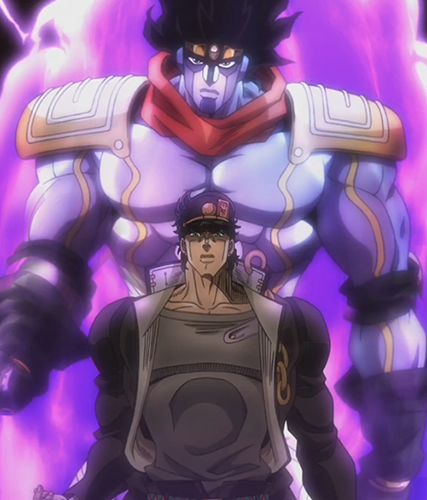JoJo’s Bizarre Adventure Anime Review: Obscurity on the Weekly #5
February 27, 2018
Welcome to Obscurity on the Weekly, the series that should really change its name to monthly at this point. This time on the chopping block is JoJo’s Bizarre Adventure, known to fans as simply JoJo’s, a manga series from way back in the 80’s, specifically its more modern anime adaptation, of the first four parts.
JoJo’s Bizarre Adventure, written and illustrated by Hirohiko Araki, is a manga series that debuted in Weekly Shonen Jump magazine in 1987, before being moved to Ultra Jump in 2005. The manga has been officially translated by Viz Media, and partially adapted into animation by David Productions starting in 2011. The anime, directed by Naokatsu Tsuda and written by Yasuko Kobayashi, can be watched on Crunchyroll, with both English subtitles and an English audio track
The story can be separated into 8 distinct parts, each with a different protagonist, each one a descendant of the first protagonist Jonathan Joestar, and each one having a name that can be abbreviated as JoJo. These 8 parts can then be separated into 3 main story arcs. The first three parts, Phantom Blood, Battle Tendency, and Stardust Crusaders focus on the feud between the Joestar lineage and the vampire Dio, as well as the mysterious stone mask that changed him into a vampire. The next three parts, Diamond is Unbreakable, Vento Aureo, and Stone Ocean, follow the story of a strange arrow that grants a psychic power known as a “Stand” when it pierces the skin. The final two parts as of yet, Steel Ball Run and JoJolion, take place in a separate universe from the first six parts, but otherwise have not yet shown a clear theme.
The first two parts are martial arts adventure series, using an ancient art known as “The Ripple” or “Hamon” to defeat vampires and zombies. Starting in part 3, Stardust Crusaders, the series introduces Stands, which are ghost-like manifestations of your fighting spirit, usually having a unique ability, which varies up the battles. Diamond is Unbreakable changes the format from an adventure series to a small town paranormal mystery, focused on capturing a serial killer that threatens the town of Morioh. Vento Aureo is a mobster story taking place in Italy. Stone Ocean takes takes place in a prison and focuses on the ominous prison minister Enrico Pucci. Steel Ball Run takes place in an alternate version of the world from the first six parts, and follows a horse race across the United States. The currently running JoJolion is set in the alternate universe counterpart to Morioh from part 4, and follows an amnesiac protagonist in search of his lost memories.
Only the first 4 parts have currently been adapted into animation, with the 5th part being anticipated, but no release date is confirmed.
JoJo’s is a series that is difficult to talk about using broad strokes. Not only do the narrative and tone vary drastically from one part to the next, but things that typically remain static, such as genre and art style also show a clear evolution. For this reason, and to make sure that each part gets its time in the limelight, it is best to cover each part in more detail.
Series Overview
At its heart JoJo’s is, as the title would imply, an adventure series. Though, this does not mean that the protagonists are always on the move, with parts four, five, and six primarily taking place in one location.

The series’ logo
The real adventure comes from the varied supernatural and mysterious elements the protagonists encounter along the way. Despite originally seeming to involve classic movie monsters, vampires and zombies in JoJo’s possess many strange abilities that only Hirihiko Araki could have conceived of. In later arcs, Stands, an original concept of Araki’s, serve the same purpose, with even more varied and unique powers. This gives the narrative a lot of freedom, and nearly anything could happen. Some of the most entertaining Stand abilities range from an enemy that attacks you in your dreams, a Stand that can shape-shift into a large boat, and even a clairvoyant comic book.
JoJo’s is known for it’s very distinctive and unique artstyle. Despite being what the series is known for, the artstyle shifts quite a bit, starting with hulking masculine powerhouses, and progressively becoming more slender and feminine as the series continues. At the very beginning of the manga, the art is off putting and inconsistent, although this was fixed in the anime, and showed chiseled faces on top of fitness god level bodies. This continued into the second and third parts, although with increasing emphasis on fashion. By the fourth and fifth parts, the art has become relatively feminine, and most characters are slender rather than the giantesque muscle heads of previous parts. One thing that is consistent among all parts is an emphasis on unusual and flamboyant posing.
This battle of the week format can be both a great strength and a crippling weakness. On one hand, it allows you to jump in at any episode, and keeps the tone breezy and fun. On the other hand, there can be large stretches of episodes or chapters where the status quo remains nearly the same, and it can be tiring to go so long with such minimal progression.
Due to this formula, the quality of any part of JoJo’s comes down to it’s protagonists and the main antagonist.
Part 1: Phantom Blood
The first part, Phantom Blood, which takes place in late Victorian Era England, follows Jonathan Joestar, a young man from a rich, polite, courteous, family, possessing a strong sense of justice. His main companions on his journey are William Zeppeli, a mysterious master of the martial art Hamon, who plays the role of mentor, and Robert E.O. Speedwagon, a hot blooded, but loyal and honorable street thug, who plays a more comedic role in the story.

Promotional art featuring Jonathan(left) and Dio(right)
Before them is Jonathan’s adopted brother, Dio Brando, who was born into a poverty stricken and abusive household, thus causing him to develop a strong desire to rise up in the world, and try to kill Jonathan’s father in order to inherit the large family fortune. After being caught red-handed, Dio uses a stone mask to transform himself into a vampire, in order to attain power through more direct means.
Phantom Blood is so early into Hirihiko Araki’s writing, that it lacks some of the charm of his later works. Jonathan makes a good “first JoJo”, as a symbol of valor and virtue, but this theming, while successful, leaves Jonathan as somewhat of a static character. Dio on the other hand makes for a great villain, a villain who is clever, irascible, and delightfully sinister. The supporting cast of Zepelli and Speedwagon are entertaining, but leave no lasting impact.
The biggest advantage of this part over others is the powerful chemistry between Jonathan and Dio. Their relationship is spectacularly developed, and adds a lot of depth to both of their characters. While initially seeing him as a spoiled brat, due to his privileged upbringing, as Jonathan overcomes the various trials Dio puts him through, Dio comes to greatly respect the man, perhaps sympathizing with him, and admires his determination and his ability to rise above his limitations.

Dio as a vampire
In turn, despite all of the hell that he has been put through, Jonathan can not find it within him to hate Dio. He recognizes that Dio must be stopped, but Jonathan can never forget the love he has for his adopted brother. No matter how despicable of a person Dio has become, he and Jonathan grew up together, and that bond remains in the back of Jonathan’s mind.
Overall, the first part of JoJo’s is greatly overshadowed by what is yet to come. Not only are the characters hit and miss, but other than the main fights, such as the final confrontation with Dio, the fights are not as exciting as those in later parts, and feel like cheap filler.
Part 2: Battle Tendency
The second part of JoJo’s takes place in late 1930’s, starting in New York City. Joseph Joestar, Jonathan’s grandson, and the protagonist of part 2, Battle Tendency, is a sharp contrast to Jonathan’s gentlemanly demeanor. Joseph is rude, loud, and quick to anger, but also shows the loyalty, protectiveness, and sense of justice as his predecessor. When not involved in situations that bring him to anger, Joseph is generally laid-back and somewhat goofy, sometimes even openly taunting his opponent, or making cheeky comments as a joke. His catchphrase is a great example of this, as Joseph confidently declares “Your next line is…”, before accurately predicting his opponents upcoming words, and deftly demonstrating how he has outsmarted them.
Another divergence between the two is the way they fight. Jonathan’s combat had a focus on his constant improvement, but Joseph fights with trickery and tactics some might call underhanded. This adds an extra layer of strategy, and greatly increases the entertainment value. Compared to Joseph’s clever schemes, Jonathan’s fighting is almost as disappointing as Mayweather vs Pacquiao.
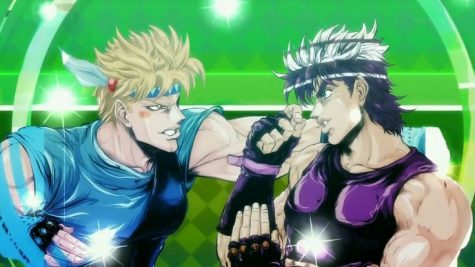
Caesar Zeppeli(left) and Joseph Joestar(right)
Similar to the first part, a large part of the appeal in Battle Tendency is found in one relationship, this time with Joseph’s rival Caesar Zepelli, grandson of William Zepelli, rather than the main antagonist. Caesar is what Tv Tropes would refer to as “The Lancer”, a direct foil to Joseph, but at the same time his closest ally. Whereas Joseph is belligerent and somewhat disagreeable, Caesar is cool and collected. Caesar is a suave and romantic ladies man, while Joseph is blunt and tactless in his interactions with women. Caesar gets his combat skills from years of disciplined training, contrasting against Joseph, a natural genius of Hamon who tends to rely on intuition, and fly by the seat of his pants.
Where the two unite is in their passion for battle, and great respect for each others abilities. While their initial meeting shows them butting heads, upon seeing the other’s commendable talents they begin to hold each other in high regard, and grow closer as the part goes on. Joseph begins to rely on Caesar’s cool head and honed instincts, and Caesar comes to trust Joseph’s quick wit, and understand his scattered thought process.
The supporting cast shows the return of Speedwagon, whom Joseph views as his uncle, and introduces Rudol von Stroheim and Lisa Lisa. Stroheim is a Nazi scientist who helped unearth the main antagonists of this part, and now seeks to destroy them in order to atone for his mistakes. Despite his job title, Stroheim earns the respect of the other characters for his self-sacrifice and adamant nature. Lisa Lisa plays the role of mentor in this part, tutoring Joseph and Caesar with a harsh but effective routine. Compared to William Zepelli from Phantom Blood, Lisa Lisa takes a much more active role in training Joseph and Caesar, as well as taking part in more battles along the way. William Zepelli you are told is strong, Lisa Lisa proves her power many times over.

The Pillar Men, from left to right Kars, Wamuu, and Esidisi.
The primary antagonists of part 2 are the ancient and mystifying Pillar Men, the remains of a race of bygone super-humans. The four Pillar Men that appear directly all have superior strength, speed, and intelligence compared to humans, and have various special abilities. The leader of the Pillar Men is Kars, a ruthless and intelligent foe, who was the original creator of the stone mask from part one. Kars has a 6 inch blade protruding from each wrist, which he uses for combat. His compatriots Wamuu and Esidesi control wind, and fire, respectively. Esidesi is a determined and loyal ally to his fellow Pillar Men, a trait which Joseph respects, and Wamuu is exceptionally honorable and moral, with a code of honor resembling that of a knight, earning Joseph’s admiration.
The Pillar Men seek the “Red Stone of Aja”, a jewel that amplifies energy, and would allow them to unleash their true power. Conversely, Joseph and Caesar seek to stop the Pillar Men and destroy them before they become even more fearsome.
Part 2 is miles above the first part, primarily due to Joseph Joestar. Compared to Jonathan, Joseph is much more lively, and is much more of a force of personality. His relationship with Caesar also adds a great deal of weight to his character. The primary antagonists are less strong characters than Dio was, but the part makes up for it with their increased presence. The minor villains in part 2 take up much less of the spotlight, allowing the Pillar Men room to assert their dominance, whereas Dio had relatively little screen-time. The battles of the second part come alive due to Joseph’s clever maneuvering, which has become a standard of the series. The supporting cast adds a lot more to this part than the first part’s, which mostly stood on the sidelines and just reacted.
Part 3: Stardust Crusaders
Part 3 begins with a time and location change, taking place in 1989 Japan. In another stark change, Jotaro Kujo subverts JoJo tradition in several ways. First of all, Jotaro is the first JoJo protagonist to actually be from Japan, the son of Joseph’s daughter and a Japanese businessman. Secondly, Jotaro is the first in a long line of Stand users in the Joestar lineage, Stand being a physical representation of your fighting spirit, often used in battles. Third, and most important, we meet Jotaro during a stay in jail.
On the surface, Jotaro is the classic Japanese delinquent archetype, cold, violent, and quick to anger, wearing an all black, modified school uniform. Where Jotaro differs is in the fact that this is just an act. To a certain extent, Jotaro is an angry person, however, Jotaro is not as cold as he presents himself. Jotaro is a character who closes himself off from others, in order to protect them. His stay in jail was for this reason, he had recently discovered his Stand, Star Platinum, an incredibly strong, fast, and precise Stand, with no particular ability, and was locking himself away until he understood it well enough to control it.
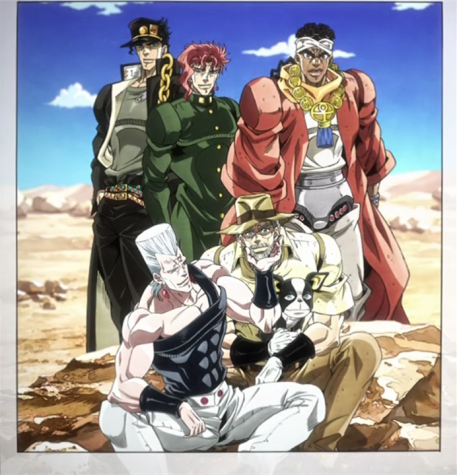
The main group featured in Stardust Crusaders, Back row, left to right, Jotaro, Kakyoin, Avdol
Front row, left to right, Polnareff, Joseph, Iggy
Jotaro is, in reality, very kind and intelligent, and this shows through in his actions. In one episode, upon learning that the enemy he had defeated was under mind control, Jotaro risked his own life to save his foe. When prompted about why he went so far, Jotaro simply replied “I don’t know, myself.” Jotaro also has a hammy side, as he idolizes Clint Eastwood, and often makes goofy one liners with a completely straight face.
Compared to the preceding parts, Stardust Crusaders has the largest main cast, with a group of 5 consisting Jotaro’s party, but to allow for this the secondary cast is very small, with only 2 to 3 recurring characters outside of the party.
The first character to appear in the part other than Jotaro is his mother, Holly Kujo, whose sudden illness is the motivation for her son and her father Joseph Joestar, returning cast member, and a main character of the part. As early as the first episode we are told of Stands, that Joseph and Holly have developed them as well as Jotaro, thanks to the return of Dio, who stole Jonathan Joestar’s body, and awakened the Joestar families’ Stands. Unfortunately, due to Holly’s gentle nature, she cannot control her Stand, and it begins consuming her life energy. By stopping Dio, Holly’s Stand would return to being dormant, and cease to be an issue.
This is primarily told to us by Avdol, an Indian Stand user who despises and fears Dio, thus ventures to rid him from this world. The first two enemies they encounter turn out to be brainwashed by Dio, and join the party after being rescued. The first is Noriaki Kakyoin, a polite and intelligent young man who helps on the journey out of gratitude for those who saved him, shortly followed by the second, Jean Pierre Polnareff, a passionate and masculine Frenchman who vowed to avenge the death of his sister, and pay Dio back for using him. About halfway through the part, a Stand using dog named Iggy joins the party, much to his chagrin, as he hates people and wishes to be left alone.
Joseph in part 3 is shown to be significantly matured, although he still has a goofy side. Joseph works as the navigator of the group, and plans out the routes they take, in addition to his comic relief role. Avdol is usually very serious, and provides sage advice, knowing the most about Stands. Kakyoin is generally pleasant and congenial, and displays a wide array of knowledge. Polnareff is hasty and reckless, getting himself in trouble quite often. Iggy runs off from the party for most of the battles, and enjoys pulling pranks and terrorizing them when he is around.
Dio, the opponent they must face once again, awaits them in Cairo, Egypt, and sends various assassins to impede them on their path. While the minor villains are still for the most part lackluster, the element of Stands adds a layer of intrigue to the battles themselves, helping, but not alleviating the boring characters.
Stands are physical manifestations of one’s fighting spirit, themed first after the Tarot, and later after Egyptian gods, and often come with powers from the simplicity of punching, to something as convoluted as transfering your pain onto someone else. Jotaro, as mentioned above, wields Star Platinum, a Stand that has excellent speed, power, and precision, but works at a short range and possesses no special ability. Joseph and Kakyoin have Hermit Purple and Hierophant Green, respectively, both of which can be extended as long tentacles, with Hermit Purple having powers related to technology and information gathering, and Hierophant Green having a wide ranged projectile Emerald Splash. Avdol’s Magicians Red controls the power of fire, Polnareff’s Silver Chariot wields a rapier and boasts incredible speed, and Iggy’s The Fool can glide, and reform itself with sand, making him very useful in Egypt.
The introduction of Stands changes the flow of combat. Battles in part 3 and beyond focus on discovering the abilities of the opponent’s Stand, and finding weaknesses therein. This change allows for more variety, as every Stand has a different ability.
There are two major villains in part 3, the first being Dio, as well as Enya, the user of Justice, an old woman who taught Dio how to use his Stand, and is seen assisting him for the part. Dio’s Stand, The World, is an important mystery that the protagonists have to unravel before they have a chance to defeat him. Without knowing The World’s ability, the heroes will sure fall before him.
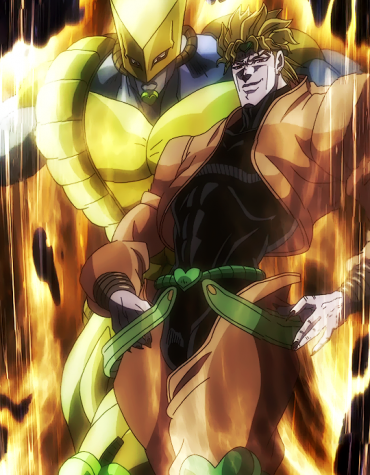
Over the almost hundred year span of time Dio has been alive, he has grown much more contemplative and philosophical. Dio has two primary goals, the first being to destroy the Joestar bloodline, which feeds into this larger goal of overcoming his fear. Dio fears the possibility that someone could possibly be powerful enough to defeat him, and this fear has driven him to isolate himself. The Joestars are the first targets for him, because Jonathan had proven himself before, and his relatives are bound to be dangerous as well. Part 3 Dio is even more dangerous than Dio from part one, and his calmer demeanor helps contrast this. Dio does much musing in part 3, about philosophical thoughts such as the meaning of contentedness, and this makes him interesting to watch.
Stardust Crusaders makes a satisfying entry in the JoJo’s franchise, with fun battles, endearing characters, and Dio’s fantastic return. Unfortunately, Part 3 suffers the most from the monster of the week format, as much of the journey is spent simply travelling, with no major plot events happening until the end. The climax absolutely fantastic, and the final confrontation with Dio is one of the best fights in the series, showcases all of the series’ dramatic strengths, while most of the journey highlights the comedy.
Part 4: Diamond is Unbreakable
As always, this part begins with a timeskip and location change, though not as large as the rest, skipping only 10 years ahead, into 1999, and the small Japanese town of Morioh. Josuke Higashikata (the suke can also be read as jo) is the protagonist this time, and is the illegitimate child of Joseph Joestar and Tomoko Higashikata. Josuke is a high school freshman at the time of the story’s beginning, and lives with his mother and grandfather on his mother’s side. Josuke is amiable and friendly in most situations, and usually acts out of genuine kindness and care for others. Josuke shows no difficulty in befriending people, even managing to become friends with a few of his enemies as the story goes on. This kindness goes beyond the average person, as when he is told of his relation to the Joestars he apologizes for being a “bastard child”, instead of being angry that his father was a married man who abandoned his mother, and relinquishes any claim of inheritance. He is agreeable to the point of occasionally being passive about being picked on or antagonized by his peers.
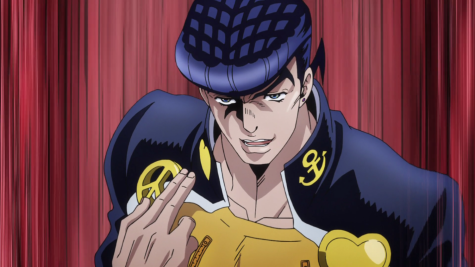
“What’d you say about my hair?”
Josuke does have a few things that will set him off, however. First and foremost is any threat towards his town or loved ones. Josuke is incredibly loyal, and is willing to go to great lengths to protect the things he cares about. Less important, but even more maddening for him is comments about his rather bizarre hairstyle. Any comments about his hair will cause him to become belligerent, and prepare for a completely unnecessary brawl.
Josuke’s main motivation throughout the part is to protect Morioh from any supernatural threats, but this does not keep him from goofing off and prioritizing time with his friends as well, being a teenager after all. Josuke is very open with his emotions, and is not embarrassed to be goofy in public. Despite Josuke’s laid back personality, he takes an active role in solving the many supernatural mysteries facing Morioh, using his Stand, Crazy Diamond, a reference to the Pink Floyd song “Shine on You Crazy Diamond”, that can repair things that have been broken, and having comparable physical attributes to Jotaro’s Star Platinum, as well as being assisted by other Stand users.
The first Stand user Josuke meets is the returning Jotaro Kujo, who has aged considerably, and shows a great deal of maturity compared to his first appearance, no longer acting like a delinquent. During the gap between parts, Jotaro went to college to become a marine biologist, and has continued fighting Stands during this time. Koichi Hirose is a meek friend of Josuke’s who begins to get more assertive after he develops a Stand, Echoes, which can write a word on a surface, causing it to be heard at various volumes by the target, over and over. Okuyasu Nijimura is an impulsive and aggressive teenager, who has a heart of gold despite this, and wields The Hand, a Stand that can erase matter from a space it attacks, or replaces it with nearby objects. Rohan Kishibe, a few years older than the high schoolers in the cast, is a successful comic artist, who is shown to be very narcissistic and unapproachable, and as a result doesn’t have many friends. Rohan’s Stand, Heavens Door, named after the Bob Dylan song “Knockin’ on Heaven’s Door”, can write commands on someone, usually “cannot attack Rohan Kishibe”, forcing them to obey that command.
The nature of the story is fundamentally different than the parts so far; instead of following the protagonists on an adventure, the entirety of part 4 takes place in Morioh, and there are a lot more slice of life moments. The monster of the week format still stands, but the tone is a lot more relaxed outside of battle. Since the scale of part 4 is so much smaller, the villain of course is less of an all powerful god figure like Dio or the Pillar Men, instead being a serial killer that is made much more dangerous by possessing a Stand.
Yoshikage Kira is a very neurotic and psychotic man, who in his own words “Just wants a peaceful life” but also has killing in his nature. Kira is an obsessive man, who compulsively avoids standing out, to the point of never placing better than 3rd in any competition. When his goal of a peaceful life seems assured, Kira is upbeat and self-assured, however when he feels threatened he will become unstable and filled with indignation. Although he presents this unremarkable front to others, Yoshikage Kira is a deeply freakish person, who fanatically pursues women with “beautiful hands” as targets for his murders. Kira tries to solve most problems indirectly, but will stop at nothing to maintain his way of life. Kira is enjoyable to watch, his disgusting behaviour makes it very satisfying to see him get taken down.
Kira’s Stand, named after the Queen song Killer Queen, perfectly pairs with his personality. Killer Queen has the power to plant bombs on anyone or anything, that when detonated, completely erases any evidence of the victim’s death. Killer Queen also has a secondary bomb, Sheer Heart Attack, named after another Queen song, which is heat seeking, and will continue seeking out and exploding heat sources until it reaches it’s target. This power makes direct encounters with Kira rare, but makes him a consistently looming threat, incredibly dangerous from any distance.
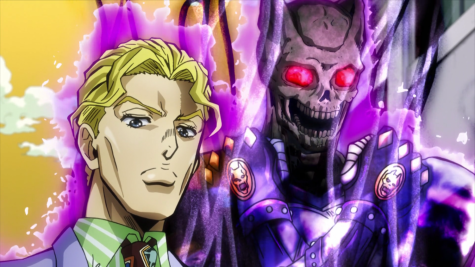
Kira with his Stand, Killer Queen
Part 4 focuses on the hunt to find and stop Kira, as well as being a fun and entertaining watch in the interceding times. The biggest appeal of part 4 over other parts is the laid-back tone, and fun slice of life.
Conclusion
JoJo’s Bizarre Adventure is a mixed bag of entertainment. Depending on the part, the quality varies wildly, although it never crosses over into bad. If JoJo’s seems like your thing, you will likely enjoy it, but it may take some time before it starts to really get good. If you’re interested in trying the series, I recommend at least watching the first season, which covers both part 1 and part 2, before making a decision. If you enjoyed what you watched, the rest of the series will not disappoint you, but if you’re not impressed by the end of part 2, the show is probably not your cup of tea.
Overall, my ranking is Stardust Crusaders in first, followed by Diamond is Unbreakable, then Battle Tendency, with Phantom Blood being my least favorite.
Be on the lookout for more Obscurity on the Weekly.


